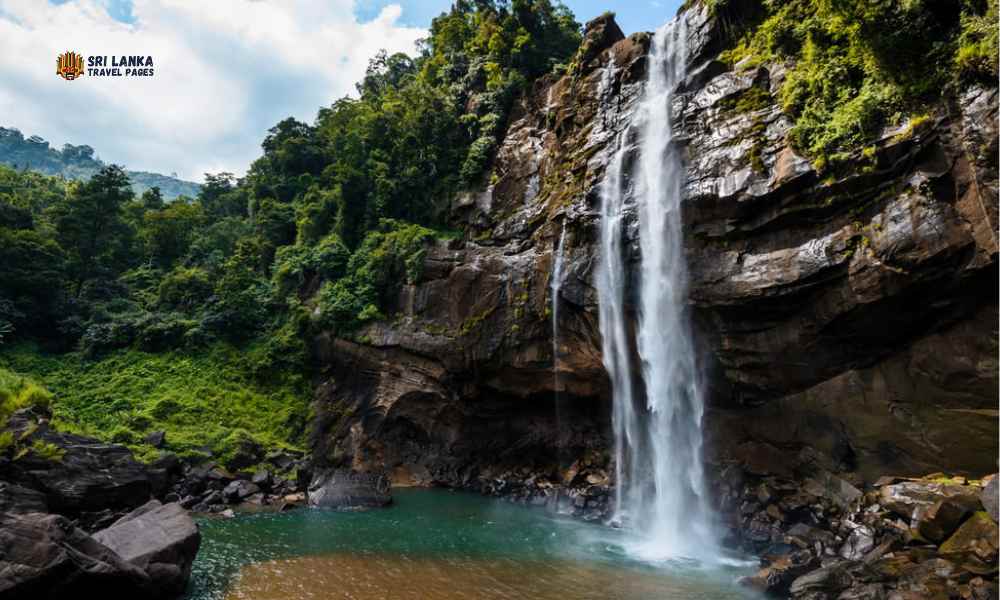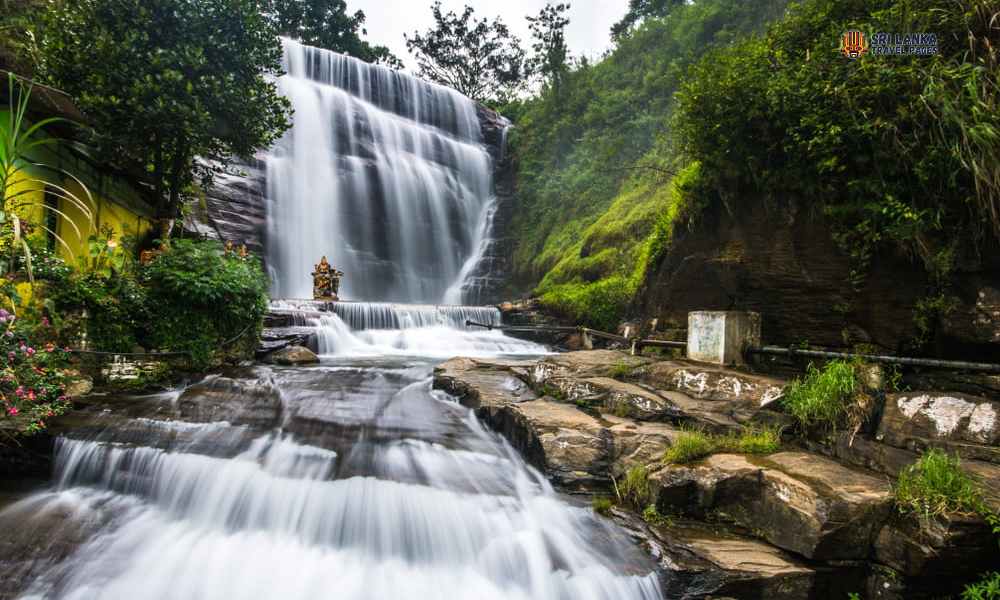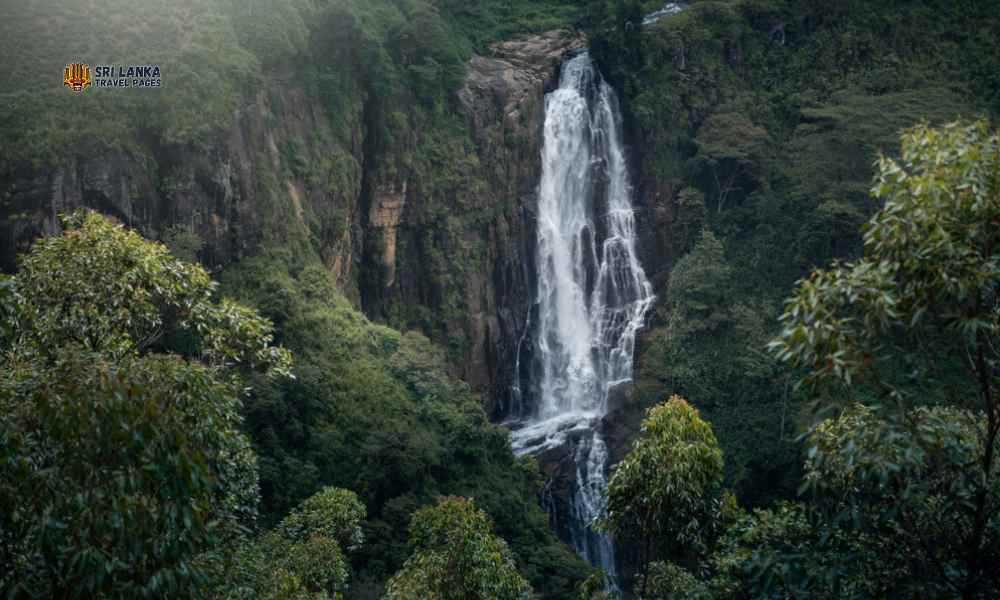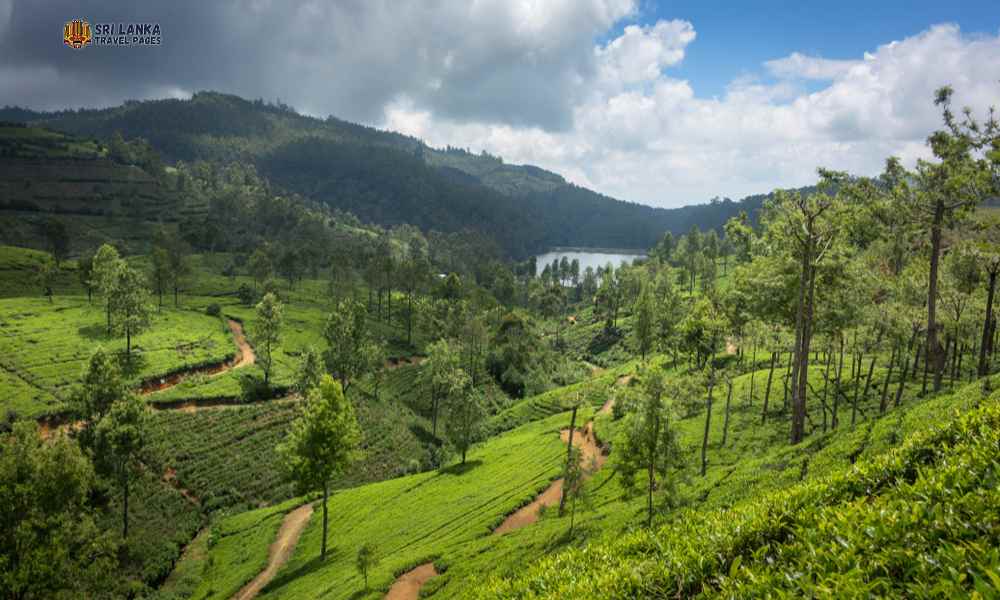
Nuwara Eliya town and the surrounding area are one of the most vibrant locations in Sri Lanka, where you can spend prolonged lush greenery and calm weather. The Area is the ideal roost for families and couples to have an unforgettable experience. Adding to your bucket list and explained the Places to visit in Nuwara Eliya and enjoy a relaxing and stress-free journey on your next visit to a remarkable city. In Addition, Nuwara Eliya is a charming countryside spot for those who adore nature blended with classiness.
1. Gregory Lake
Gregory Lake is a beautiful area in Nuwara Eliya with both foreign tourists and locals. Titled after Sir William Gregory in 1873, it is a prominent attraction utilized for water sports and recreational activities. The park near the lake gives you several activities, such as speed boats, swan boats, dinky boats, Pony rides and many more. In addition, there is a bicycle path around the lake. Plenty of fast food stalls are located in separate areas to enjoy a meal or a snack. More Details
Ticket price: LKR.20 (Locals)
LKR.200 (foreigners)
Charges for Car Park
SUV / Van – 250 LKR Car – 125 LKR Bus – 650 LK
Opening Hours – 06:00 a.m. to 06:00 p.m. (No admission after 03:00 p.m.)
2. Victoria Park -Nuwara Eliya
Victoria Park in Nuwara Eliya, named after Queen Victoria’s 60th jubilee and built-in 1897, has 27 acres. The place where most prominent travellers, especially holidaymakers, nevermore abandon to visit and enjoy the beautifully set out gardens with the colourful flora and fauna maintained beautifully by the City Council. The blossoms are in full bloom in March, April and May and repeat in August and September. There is a particular area for the kids to play. More Details
Ticket Price: LKR 300
Opening Hours: 9 a.m. – 6 p.m. (weekdays)
7 a.m. – 6 p.m. (weekends)
3. Galway’s Land National Park
Galway’s Land National Park The alone national park located within Nuwara Eliya city limits, Galway is residence to a montane ecosystem in the cold and windy hill station of Nuwara Eliya, also the most eminent placed city in Sri Lanka. Galway’s is enhanced by its unique birds and colourful floral varieties of native and foreign influence. Simultaneously with the nearby Victoria Park, Galway is considered the most important birding area in Sri Lanka. More Details
4. Single Tree Hill
Single Tree Hill, An outstanding sunrise view, can be viewed from the top of this mountain. Located 6890 ft higher than the sea level and takes about 90 minutes to reach the top. Single Tree Hill is the most excellent vantage point from which to watch the majesty of Nuwara Eliya and the beauty of the Haggada Mountain range. After trekking within tea plantations, one arrives at the top, where there is simply one Singletree. That is the 7th highest mountain in Sri Lanka.
A Buddhist temple is as peaceful as it can get your mind off the trail for a while, a great place to rest and walk around. There were stone stairs from the temple houses to enter the main hall and other structures. Following touring the Temple, The tip with a radio tower is visible nearly all the way. The trees have adjusted to the cold weather, heavy downpours and intense sunshine. Walking in the morning tide is ideal for bird spectators. The endemic whistling thrush, yellow-eared bulbul and several other species occupy this tiny forest patch. Mammals like sambar deer and barking deer can be observed further. Following that trail, you’ll end up in a tree plantation and can go through it down the hill, where you can get panoramic scenes of the town and lake. If you’re feeling a bit more adventurous, go a little more under for more angels. The single Tree Hill trail is well worth visiting, but if you prepare to walk in the rainy year, check for weather warnings in advance, as it limits the appearance. More Details
5. Aberdeen Waterfalls
The Aberdeen Waterfall remains one of the most iconic waterfalls in the Nuwara Eliya district! Reaching the cascade involves a reasonably challenging hike that will take you down a winding pathway composed of narrow staircases and paths laid in concrete. The walk will take you through lush undergrowth, usually darkened by the thick canopy – the hike is so scenic that many would find it very therapeutic. During the journey, one could listen to the sweet melodies of songbirds and the slow buzzing sound of the insects and witness such creatures. There are unique plants, and you will also walk past several creeks, large boulders, and vines. At the End of the trail lies the waterfall –magnificent, epic, and stunning; all the elaborate words fail to describe its beauty – It is a site that must be visited to understand and appreciate its splendour!
Explorers and adventurers can walk to the bottom of the waterfall where there is a pool, but bear in mind that it is relatively deep, and the water will be cold, so swimming is not recommended. But instead, you could rent a kayak and paddle below the cascade. The mist from the waterfall will undoubtedly soak up your clothes, so make sure you are clad in proper swimwear. The return journey will also be scary since you must climb your way up, which you quickly get down! You can find more information about the site from our reception, and excursions to the site or transportation can also be arranged by contacting our resort’s front desk. More Details
6. Laxapana Waterfalls
Laxapana Falls holds a grand 126 metres in height. Waterfalls would make it the country’s eighth tallest waterfall, only surpassed by behemoths like Dunhinda and Babarakanda Falls. Specifically, it is located in Nuwara Eliya – in the Maskeliya, directly next to a little village named Kiriwan Eliya. The Laxapana Falls was initiated by the Maskeliya Oya, right around the extent that it formed up with the Kehelgamu Oya to form the famous Kelani River. Currently, the waterfall is named the Laxapana Hydro-Electric Stations, which are found close to each other. These are significant sources of power for the whole country. More Details
7. Haggala Botanic Gardens
Haggala Botanic Gardens were established in 1861 to experiment with and improve Cinchona cultivation in Sri Lanka. The fields in the hill country among Sri Lanka’s tea plantations in the Nuwara Eliya district are placed along Badulla Road, 9.5 km southeast of Nuwara Eliya.
The abode at about 1745 m above sea level; Hakgala Botanic Gardens, about 28 hectares in Area, lies under the darkness of the Hakgala Rock. This large rock towers about 2,200m behind the gardens and the neighbouring forest reserve like a lonely giant. The gardens take the shape of several platforms upon the lower slopes of the rock and meet the Uva Valley, across which some majestic views of the Madulsima and the Namunukula range of hills are seen in the different landscapes. The environment of the Gardens is subtropical, cool, fresh, and slightly similar to an alpine climate—the temperature changes from 3°C to 15° C. The lowest reported was 3° C. The gardens receive rainfall from two monsoons. In the South West from May to August and the North East from October to December, the yearly average rainfall is about 2300 mm. More Details
Entry: LKR. 60 for Locals
LKR. 1500 for Foreign Adults
LKR. 750 for Foreign Child
Opening Hours: 8 a.m. – 5.30 p.m.
8. Seetha Amman Kovil
Seetha Amman Kovil has located just 1 km from the Hakgala Botanical garden. Uniquely Seetha Amman kovil is in the world and is established according to South Indian architecture. According to the Epic Ramayana, legend has it that Seetha was held captive and hidden in this place by king Rama to protect her from the brute king Ravana. The stream that runs close to this place is believed to be where Sita bathed, and the rock by it is thought to be where she lay praying. On the rock face across the water are circular depressions believed to be the footprints of Rawana’s elephant. There is one place in the stream where the water cannot be drunk, and myth has that Sita cursed this place and hence the sour taste. Water is bright, and the Temple is known by many other names such as Sita Amman Kovil, Sita Amman Temple, Hanuman Kovil, Hanuman Temple, and Sri Bhakta Hanuma Kovil belong to the same place. More Details
9. Dunsinane waterfalls
The beautiful Dunsinane Falls, also called Pundalu Oya, falls in Pundalu Oya village, Nuwara Eliya district of Sri Lanka. With a rise of 100 m, the waterfall, in subsequent runs, joins the Pundalu Oya River, a branch of the Kotmale Oya.
Dunsinane falls lies between a couple of tea estates. One is named Dunsinane estate, and the other is called Sheen estate. Consequently, this waterfall was called Dunsinane-sheen falls (or Dunsinanshin falls). After an appropriate time, this waterfall was named ‘Dunsinane Falls.’ The top part of the fall is 30 meters, and it flows through a vast rocky plain. There is a Hindu Kovil on the left side of the upper falls, and a statue has been made in the middle of the stony plain, which adds a unique value to the waterfall. Waterfalls feature you can observe from the bridge. The 70m lower part cascades down the bridge, and there is no proper way to reach the base of the lower segment. More Details
10. Sri Bhakta Hanuman Temple
Sri Bhakta Hanuman Kovil Temple is one of the essential Hanuman Temples in Sri Lanka, found on the peak of the spectacular panoramic hill in Ramboda, 30 KM northern to Nuwara Eliya. The Chinmaya Mission of Sri Lanka began this Hanuman Temple in Ramboda. Shri Bhakta Hanuman Kovil temple is dedicated to the God Hanuman, one of the important sites of the Ramayana Tour in Sri Lanka. In addition, visitors can observe the 18 feet Hanuman sculpture, the tallest Hanuman sculpture in Sri Lanka.
Hanuman Temple was built in 1999, and it is considered that Hanuman was seeking Sita Devi. Nonetheless, some Ramayana details are obtainable in this Zone, a town named “Ravana Goda” close to this Bhakta Hanuman kovil Temple. Also, the Tamil word for Ramboda, Rampadai, intends “Rama’s force”; this is why Ramboda is believed to be the Area where Rama raised his troops. Besides, it is thought that this was where Lord Hanuman took a break while seeking Sita during the Ramayana yatra to Sri Lanka. More Details
11. Devon Waterfalls
Devon Waterfalls, identified as the ‘Veil of the Valley, is a waterfall in Sri Lanka, found 6 km west of Talawakele, Nuwara Eliya District. The falls are after a pioneer English coffee agriculturist, Devon, whose plantation was near the falls. The cascade is 97 m high, the 19th highest on the island. The river of Kothmale Oya, a part of the Mahaweli River, frames the fall. The height of Devon Falls is 1,140 m above sea level. More Details
12. Pidurutalagala Mountain and Forest Reserve
Pidurutalagala, or Mount Pedro, is an ultra-extended peak and the tallest mountain in Sri Lanka, at 2,524 m. It is situated North-next-east of the town of Nuwara Eliya and is easily visible from most areas of the Central Province.
During particular times of the year, one may be fortunate enough to travel up to Pidurutalagala Peak after obtaining permission ( no trekking allowed) without stopping the vehicle on the way or getting out of the car from the Entrance Security Point at the mountain base up to the Upper-Security Point at the peak. More Details
13. Strawberry Farm
Strawberries are grown in open areas and polytunnels in the Nuwara Eliya District. Two of the most famous plantations are in Ambewela and Ragala, about 30 minutes from Nuwara Eliya.
Although the initial planting season for strawberries begins in September, the nursery preparation method starts fresh with farming mother stock. Served with the utmost care, these mother plants start shooting branches a few weeks after planting, which are then separated and potted in preparation for bed farming.
Greenhouse construction involves carefully laying gradients for proper effluent, mulch for suitable weed/pest cover and dripper methods for fertigation – a few of the multiple features covered meticulously in this period. As we call the formation of the soil and Area, Land and bed preparation is an arduous task requiring much precision and time. More Details
14. Gartmore Waterfalls – Maskeliya
Gartmore Waterfall is generally known as Sri Pada Waterfall or Adam’s Peak Fall due to its closeness to Adam’s Peak. However, because this waterfall occupies the Gartmore estate, it is also recognized by Gartmore Falls.
Gartmore Falls immediately befalls onto the Maskeliya Reservoir and is fed by two rivers that join over the falls. Each of these waters creates a waterfall before joining and lying inside the Gartmore Estate. Hence, these two waterfalls are commonly named Gartmore Estate Waterfalls.
A different waterfall of the same height lies several meters away from Gartmore Falls, feeding the same Maskeliya Reservoir called Moray Falls. However, due to the proximity of these two falls, some confuse the titles of those waterfalls, and the Moray Falls is also recognized as the Sri Pada Falls. More Details
15. World’s End – Horton Plains
World’s End intends that this place has the highest gap in Sri Lanka. It was situated at the border of Nuwara Eliya, Badulla and Ratnapura districts and Horton Plains, the immense biodiversity range in Sri Lanka. This place highlights the vibrant bio-diversity of Sri Lanka. With a remarkable variety of terrain, weather, vegetation, etc., this trail climbs through pine plots, grasslands, Montana brush patches, tea fields, and eventually into a cloud forest to arrive at Worlds End. One can observe the city of Balangoda, which is found way under your point of view. Walk alone within the silent plain of Horton Plain to the End of the world. Stand 2000 Metres high at the peak of the cold frosted grassland and drop your sights towards the next landmark – the tea plantations 900 Meters under. Gaze beyond the waves of mountains, the lattice of waterfalls, hazy lakes and paddy fields, the pink salters of Hambantota and the sparkling sea in a horizontal sweep. More Details
16. Baker’s Waterfalls
Baker’s waterfall is located in the Horton Plains national park; this fall is accessible from Pattipola or Ohiya town. From Pattipola, take the well-signed footpath and either follow it to World’s End and loop back to Baker’s Falls or take the right turn at the start of the path. A steep, root-strewn bank can be challenging to negotiate shortly before the fall, especially in wet weather. More Details
17. Horton Plains National Park
Horton Plain, surrounding forests, and the neighbouring Peak Wilderness connect Sri Lanka’s most significant catchment area of almost all the main rivers. The tables are also outstanding in the environments, and endemic plants and animals represent the land’s wet and montane zones.
Horton plains comprise a gently fluctuating highland hill at the southern End of the central mountains massif of Sri Lanka. It is managed to the north by Mount Totupola Kanda (2,357m) and west by Mount Kirigalpotta (2,389m). Two mountains filling the Horton Plain have added immensely to its awe-inspiring physiognomy, “big worlds end” by 884m. The sparking Baker’s fall emphasises the beauty of the foliage of the peaks encircling the plains as intermittently covered by mist. The park’s altitude covers from about 1,800m to 2,389m at the height of Kirigalpotta. The plateau at 2,100m is the most distinguished tableland in Sri Lanka. The yearly rainfall in the region is about 2540mm, but for Horton Plains, it may exceed 5000mm. Rain happens most of the year, although there is a dry season from January to March. Temperatures are moderate, with an annual mean temperature of 15ºC and ground frost is anticipated from December to February.
Horton Plains is sufficiently admitted for its rich biodiversity; its flora has a high endemism level. 5% of varieties are determined to be endemic to Sri Lanka. More Details
Ticket price : Locals- LKR 60 + LKR 300 Group Fee + 15% VAT
Foreigners -USD 15 + USD 8 Group Fee + 15% VAT
18. Chariot path- Ramboda
The Chariot path is where Ravana carried Sita Devi on his chariot from Sita Kotuwa to Ashoka Vatika, also known as Ravana field pathway, located forest on the top of Ramboda Hills on the Kandy – Nuwara Eliya main road. This is one of the iconic Ramayana places in Sri Lanka. To date, no vegetation thrives on this barren land without grass. King Ravana is assumed to have used this way on top of these hills to show Sitadevi the attraction of his kingdom, as stated in the great epic of Ramayana. Therefore, the chariot path and Sita tear pond are critical Ramayana Sites in Sri Lanka.
Barley grass can be seen during the pathway giving evidence to the remarkable story of Ramayana. However, many large trees with gorgeous red blooms in this field add a bright colour to the landscape. These flowers are called Sita flowers by the local villagers. The peculiarity of these flowers is the petal, stamen and pistil shape, which follow a human figure carrying a bow and represent Rama. It is also considered that These flowers are novel only to this region in the entirety of Sri Lanka. More Details
19. Pattipola railway station
Pattipola is the 62nd station on the central railway line and is 224 km from Colombo. That is the highest railway station in Sri Lanka, with 1,897.5 m (6,225 ft) high above the base sea level. The station has a single platform with another track as a siding loop. All the trains on the Main Line, including the Podi Menike and Udarata Menike, express trains, and check-in at the station. More Details
20. St. Clair’s Waterfalls
St. Clair’s Falls is one of the widest waterfalls in Sri Lanka and is usually known as the “Little Niagara of Sri Lanka”.The falls are located 3 kilometres (1.9 mi) west of Talawakele on the Hatton-Talawakele Highway in Nuwara Eliya District. More Details
21. Kande Ela Educational Forest Reserve
The Kande Ela Educational Forest Reserve is located on the Kande Ela tank, about 12 Km from Nuwara Eliya on the Nuwara Eliya-Pattipola Road.
This forest reserve is settled in a stunning location and environment, containing various forest fauna and flora. It also includes a very high quality of plants and is unique to the upcountry forest reservations.
Descriptive details of the Science of Environmental conservation and various related examples & models have been used to describe and explain the different aspects of Environmental Science and protection.
This natural habitat that has been prepared to understand the upcountry forest setup is full of various plants and living fauna. You can gain vast knowledge about forest conservation and its related aspects through details about the various examples and models in multiple locations of this forest reserve. More Details
22. New Zealand Farm – Ambewela
New Zealand Farm is located at Ambewela, a few km from Nuwara Eliya. The New Zealand Farm is a division of the Ambewela Farm; New Zealand Farm is located only 3-4 Km away from the Ambewela Farm. New Zealand farm raises purebred Friesian cows and maintains a pure line of cattle. The cows are provided with a rich diet and sterilized water to preserve milk quality. Exceptional health care is given on a 24 hr basis. Here, one can see the most extensive grasslands of Sri Lanka and is also a part of the Ambewela farm, which manufactures dairy products, such as milk, cheese and yoghurt and can be seen by visitors. More Details
Opening Hours : 09 a.m. – 06:00 p.m.
23. Moon Plains
Moon Plains is an ample plain land with overgrown green grass in the middle of forest reserves and peaks. This area has a fabulous view, and visitors can rest, live in the new atmosphere and sense comfortable. It gets clarity that is misplaced in complex city dynamism. More Details
Ticket price: Adults: LKR 400
Children: LKR 200
Opening Hours : 07:30 a.m. – 04:00 p.m.
24. Post Office – Nuwara Eliya
The British built a red brick building according to the Tudor technique and a two-storied structure with a clock spire in 1984. This building is in the centre of Nuwara Eliya town and is one of the oldest buildings in Sri Lanka. More Details
Opening Hours: 8 a.m. – 04:30 p.m.
25. Golf Club – Nuwara Eliya
The Nuwara Eliya Golf Club is one of the oldest golf clubs in Asia, established in 1889. It is an establishment rich in tradition and history and holds an atmosphere exceptional in this country.
Established primarily for their rest and recreation by the British agriculturalists who farmed the land for tea in the Nuwara Eliya and neighbourhoods, to this day, it caters to some of the traditions and practices of the country’s colonial history. This quaint admixture of old-world charm and modern trappings invests it with a special aura and is the essence of its beauty. When one enters the gates, one is fascinated by a world left behind by the march of history.
26. Pedro Tea State
Tea State is Located around 3.5 km east of Nuwara Eliya. Tourists can visit the Tea estate from morning until 12.30 p.m. and after 2.00 p.m. At Pedro Estate, you should be able to observe the steps of tea fabrication, grade, and filling for exports. It is situated on a landscape with green pastures of tea and waterfalls, which is a scenery never to be forgotten.
27. Ramboda Waterfalls
Ramboda Waterfalls is not a single cascade. It has two stairs. It is 109 m (358 ft.) tall and has been proffered as the 11th-highest cascade in Sri Lanka and the 729th tallest in the world. It was formed by Panna Oya, a Kothmale Oya branch, and it visited Ramboda’s main waterfall at the downside of the Ramboda. More Details
28. Bluefield Tea state
Bluefield Tea state is a renowned tea production estate in Nuwara Eliya found in Rambada, about 1200 meters beyond sea level, encircled by a pleasant and picturesque setting of lush greenery and ravines. In addition, It is the most visited tea plantation in the Nuwara Eliya, wrapped by tea estates and misty mountains. Bluefield Tea Factory is best for learning the production steps and purchasing new garden tea mixtures.
29. Lover’s Leaf Waterfalls
Lover’s Leap Waterfall, likewise understood as Lover’s Leap Falls, is a renowned waterfall attraction for visitors. The waterfall creates a beautiful spot to watch the sunset.in addition, there are no appropriate sites to park your vehicle and hiking a short distance via the tea plantation and dirt road to the falls drives you a different experience. More Details
30. Castlereagh Reservoir
The Castlereagh Reservoir is disguised in a ravine and encircled by soaring, verdant cliffs. It is possibly the most idyllic place in the hill country.
Visiting the reservoir is a beautiful activity for anyone, whether travelling with your partner, family or a group of friends. There are a whole host of outdoor activities in the area—canoe along the calm waters of the reservoir or Cycle via the surrounding ridges.
31. Grand Hotel – Nuwara Eliya
In the 1990s, The Grand Hotel was offered its title as ‘National Heritage Property’ by The Archeology Department of Sri Lanka. This prestigious title represents the value placed on the decade Grand Hotel, Nuwara Eliya, as both a historic building and a place that holds a deep historical and cultural significance for Sri Lanka, worthy of preservation.
Before its discovery by Dr John Davy in 1819, Nuwara Eliya was already home to an illustrious history that showcased ruins of ancient irrigation systems and stone reminders that dated as far back as 1000 AD. Nuwara Eliya, or the “ City of Light “, has deep roots in a popular Royal Township. The early 19th-century British Planters made plans to make this little valley a home away from home for themselves. Privy to it all, the best hotel in Nuwara Eliya- The Grand Hotel is at the heart of the merry-making, romance and history.
32. Tea Castle by Mlesana
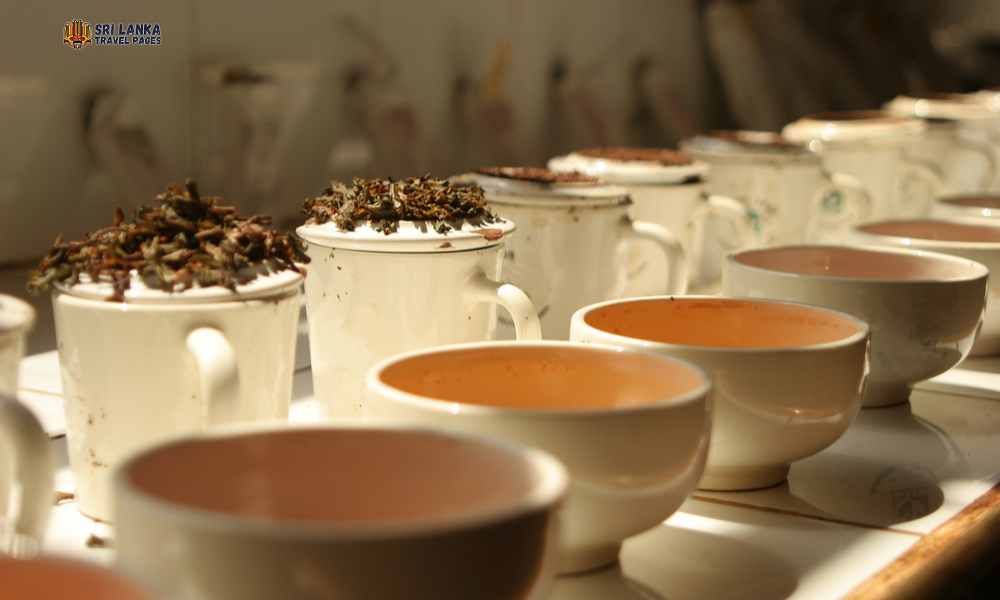
The Castle Museum displays interesting heirlooms with scholarly pictures depicting the industry’s earlier years. Further, The Castle Restaurant, with its unique atmosphere, adds substantial weight to the occasion by completing a good attitude for entertainment and leisure.
Weather in Nuwara Eliya
Nuwara Eliya is the most remarkable region in Sri Lanka due to its high-altitude level. The moderate temperature is 16°C, typically varies between 10°C to 23°C (50°F to 73°F), rarely it become below ten °C (50°F) and above 23°C (73°F). The average rain is 2050mm. The hottest is May and the most relaxed in January. October reports the highest rainfall, and July is windier, according to the weather forecasting reports. Many locals usually visit from April to May to avoid the brutal sun in Colombo.
Festival season in Nuwara Eliya
Nuwara Eliya Festival begins on April 1st and runs until April 30th with delightful events like horse races, strawberry fest, golf tournaments, water sports events, Musical events, the Gregory MUD challenge, and more.

How to reach Nuwara Eliya?
By Taxi
Bandaranaike International Airport has car assistance desks that provide transfers to Nuwara Eliya, which cost roughly USD 115 – 120 unless your hotel or tour operator arranges a transfer. The distance from Colombo BIA Airport to Nuwaraeliya is around 165 km, and it takes about 5-6 hours to reach Nuwara Eliya. Furthermore, you can find taxis or Tuk-tuk as a cheap alternative from any city to get to Nuwara Eliya.
By Bus
Direct Public transportation to Nuwara Eliya is available from many central cities, and few cities have to use transit buses to reach Nuwara Eliya.
By Air
Cinnamon Air Charters fly to Nuwara Eliya, which takes about less than an hour to reach Nuwara Eliya. Please get in touch with Cinnamon Air for your next dream visit to Nuwara Eliya.
Suggested Read – The Most Attractive Places to Visit in Sri Lanka
Article by
Ravindu Dilshan Illangakoon
As co-founder and Head of Content at Sri Lanka Travel Pages, I ensure that every blog post we publish is AMAZING.
Ambuluwawa Tower
Ambuluwawa Mountain near Gampola, Sri Lanka, is home to the notable Ambuluwawa Tower. The tower…
Kumana National Park and Safari: A Guide to Sri Lanka’s Wildlife Haven
In Sri Lanka’s southeast, a wildlife paradise is Kumana National Park. The park is noted…
Habarana Travel Guide
Located in the centre of Sri Lanka’s cultural triangle, the little hamlet of Habarana serves…





